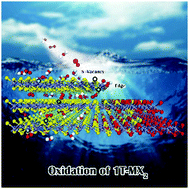Unveiling chemical reactivity and oxidation of 1T-phased group VI disulfides†
Abstract
Transition metal dichalcogenides (TMDs) are of particular interest because of their unique electrical and optical properties that evolve from the quantum confinement and surface effects. However, their long-term stability in air is proved to be a main concern for practical applications of the ultrathin materials, especially for TMDs with 1T phased structures. Here, we provide an in-depth understanding of the oxidation and degradation mechanisms of monolayers of group VIB disulfides, including TiS2, ZrS2, and HfS2. As the atomic radius of the transitional metals increases, their air stability significantly decreases and the oxidation mechanisms are quite different from one another. In particular, the oxygen induced oxidations initiated at both the surface vacancy sites and edges of ZrS2 and HfS2 are studied, while the oxidation of TiS2 starts at the edges and water plays a crucial role in the continuous oxidation process. Moreover, the defective sites expose the metals for activation and dissociation of either oxygen or water, causing the breakdown of the systems eventually. Meanwhile, these sites can be used as active centers for specific applications in catalysts and surface functionalized materials.

- This article is part of the themed collection: 2019 PCCP HOT Articles


 Please wait while we load your content...
Please wait while we load your content...